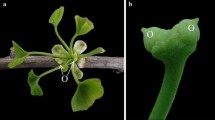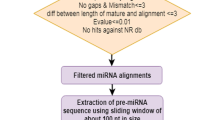Abstract
The microRNAs (miRNAs) are a new type of tiny, noncoding, single-stranded endogenous RNA molecules performing their function of regulating gene expression by targeting mRNAs for degradation or restraining protein translation. Thousands of miRNAs have been identified in many plant species to date, whereas only limited number of miRNAs have been identified in Phalaenopsis orchid. By using an exact computational analysis, 30 potential miRNAs were found from all known sequences (205 823 nt, 5505 GSS, and 8066 EST) in this study. These 30 miRNAs belong to 26 miRNA families and show significant variation in size. According to the previously established systemic method, 193 Phalaenopsis orchid genes were predicted as potential target genes of 20 miRNAs. The majority of these potential target genes in Phalaenopsis orchid encode hypothetical proteins, which functions are either indefinite or unknown. The rest miRNA target genes encode transcription factors that function in stress response, signal transduction, and a variety of other metabolic processes. To validate the predicted miRNAs and the mutual relationship between miRNAs and their target genes, qRT-PCR was applied to detect the tissue-specific expression levels of four putative miRNAs and their target genes in Phalaenopsis leaves, flowers, and roots. This study provided for some important information about Phalaenopsis pre-miRNAs, mature miRNAs, and miRNA target genes and will be helpful for future research of miRNA functions in Phalaenopsis.
Similar content being viewed by others
Abbreviations
- EST:
-
expressed sequence tag
- GM:
-
genetically modified
- GSS:
-
genome survey sequences
- miRNA:
-
microRNA
- nt:
-
nucleotide
- NCBI:
-
national center for biotechnology information
References
Bartel, D.P., MicroRNAs: genomics, biogenesis, mechanism, and function, Cell, 2004, vol. 116, pp. 281–297.
Vaucheret, H., Post-transcriptional small RNA pathways in plants: mechanisms and regulations, Genes Dev., 2006, vol. 20, pp. 759–771.
Aukerman, M.J. and Sakai, H., Regulation of flowering time and floral organ identity by a microRNA and its APETALA2-like target genes, Plant Cell, 2003, vol. 15, pp. 2730–2741.
Sunkar, R., MicroRNAs with macro-effects on plant stress responses, Stem Cell Dev. Biol., 2010, vol. 21, pp. 805–811.
Park, W., Li, J.J., Song, R.T., Messing, J., and Chen, X.M., CARPEL FACTORY, a dicer homolog, and HEN1, a novel protein, act in microRNA metabolism in Arabidopsis thaliana, Curr. Biol., 2002, vol. 12, pp. 1484–1495.
Reinhart, B.J., Weinstein, E.G., Rhoades, M.W., Bartel, B., and Bartel, D.P., MicroRNAs in plants, Genes Dev., 2002, vol. 16, pp. 1616–1626.
Wang, J.Y., Hou, X.L., and Yang, X.D., Identification of conserved microRNAs and their targets in chinese cabbage (Brassica rapa subsp. pekinensis), Genome, 2011, vol. 54, pp. 1029–1040.
Kozomara, A. and Griffiths-Jones, S., MiRBase: integrating microRNA annotation and deep-sequencing data, Nucleic Acids Res., 2010, vol. 39, pp. D152–157.
Jaime, A., Teixeirada, S., Dong, P.C., Pham, T.V., and Masahiro, M., Transgenic orchids, Sci. Hort., 2011, vol. 130, pp. 673–680.
Hsu, C.C., Chung, Y.L., Chen, T.C., Lee, Y.L., Kuo, Y.T., Tsai, W.C., Hsiao, Y.Y., Chen, Y.W., Wu, W.L., and Chen, H.H., An overview of the Phalaenopsis orchid genome through BAC end sequence analysis, BMC Plant Biol., 2011, vol. 11, p. 3, doi 10.1186/1471-2229-11-3
Hofacker, I.L., Vienna RNA secondary structure server, Nucleic Acids Res., 2003, vol. 31, pp. 3429–3431.
Xie, F., Frazier, T.P., and Zhang, B., Identification, characterization and expression analysis of microRNAs and their targets in the potato (Solanum tuberosum), Gene, 2011, vol. 473, pp. 8–22.
Wang, J.Y., Yang, X.D., Xu, H.B., Chi, X.Y., Zhang, M., and Hou, X.L., Identification and characterization of microRNAs and their target genes in Brassica oleracea, Gene, 2012, vol. 505, pp. 300–308.
Shi, R. and Chiang, V.L., Facile means for quantifying microRNA expression by real-time PCR, BioTechniques, 2005, vol. 39, pp. 519–525.
Lu, H.C. and Tsai, W.C., Strategies for functional validation of genes involved in reproductive stages of orchids, Plant Physiol., 2007, vol. 143, pp. 558–569.
Stark, A., Bushati, N., Jan, C.H., Kheradpour, P., Hodges, E., Brennecke, J., Bartel, D.P., Cohen, S.M., and Kellis, M., A single Hox locus in Drosophila produces functional microRNAs from opposite DNA strands, Genes Dev., 2008, vol. 22, pp. 8–13.
Tyler, D.M., Okamura, K., Chung, W.J., Hagen, J.W., Berezikov, E., Hannon, G.J., and Lai, E.C., Functionally distinct regulatory RNAs generated by bidirectional transcription and processing of microRNA loci, Genes Dev., 2008, vol. 22, pp. 26–36.
Frazier, T.P., Xie, F.L., Freistaedter, A., Burklew, C.E., and Zhang, B.H., Identification and characterization of microRNAs and their target genes in tobacco (Nicotiana tabacum), Planta, 2010, vol. 232, pp. 1289–1308.
Zhang, B.H., Pan, X.P., and Stellwag, E.J., Identification of soybean microRNAs and their targets, Planta, 2008, vol. 229, pp. 161–182.
Zhang, B.H., Pan, X.P., Cox, B., Cobb, G.P., and Anderson, T.A., Evidence that miRNAs are different from other RNAs, Cell Mol. Life Sci., 2006, vol. 63, pp. 246–254.
Zhou, X.F., Sunkar, R., Jin, H.L., Zhu, J.K., and Zhang, W.X., Genome-wide identification and analysis of small RNAs originated from natural antisense transcripts in Oryza sativa, Genome Res., 2009, vol. 19, pp. 70–78.
Xie, F., Frazier, T.P., and Zhang, B., Identification and characterization of microRNAs and their targets in the bioenergy plant switchgrass (Panicum virgatum), Planta, 2010, vol. 232, pp. 417–434.
Dhandapani, V., Ramchiary, N., Paul, P., Kim, J., Choi, S.H., Lee, J., Hur, Y., and Lim, Y.P., Identification of potential microRNAs and their targets in Brassica rapa L., Mol. Cells, 2011, vol. 32, pp. 21–37.
Bonnet, E., Wuyts, J., Rouze, P., and Vande, P.Y., Evidence that microRNA precursors, unlike other non-coding RNAs, have lower folding free energies than random sequences, Bioinformatics, 2004, vol. 20, pp. 2911–2917.
Zhang, B.H., Pan, X.P., and Anderson, T.A., Identification of 188 conserved maize microRNAs and their targets, FEBS Lett., 2006, vol. 580, pp. 3753–3762.
Kakinuma, M., Inoue, M., Morita, T., Tominaga, H., Maegawa, M., Coury, D.A., and Amano, H., Isolation and characterization of a SEPALLATA-like gene, ZjMADS1, from marine angiosperm Zostera japonica, Mar. Environ. Res., 2012, vol. 76, pp. 128–137.
Kang, H.G. and An, G., Isolation and characterization of a rice MADS box gene belonging to the AGL2 gene family, Mol. Cells, 1997, vol. 7, pp. 45–51.
Jeon, J.S., Lee, S., Jung, K.H., Yang, W.S., Yi, G.H., Oh, B.G., and An, G., Production of transgenic rice plants showing reduced heading date and plant height by ectopic expression of rice MADS box genes, Mol. Breed., 2000, vol. 6, pp. 581–592.
Kang, H.G., Jang, S., Chung, J.E., Cho, Y.G., and An, G., Characterization of two rice MADS box genes that control flowering time, Mol. Cells, 1997, vol. 7, pp. 559–566.
Chen, W.H., Hsu, C.Y., Cheng, H.Y., Chang, H., Chen, H.H., and Ger, M.J., Downregulation of putative UDP-glucose: flavonoid 3-O-glucosyltransferase gene alters flower coloring in Phalaenopsis, Plant Cell Rep., 2011, vol. 30, pp. 1007–1017.
Ma, K., Xiao, J.H., Li, X.H., Zhang, Q.F., and Lian, X.M., Sequence and expression analysis of the C3HC4-type ring finger gene family in rice, Gene, 2009, vol. 444, pp. 33–45.
Author information
Authors and Affiliations
Corresponding author
Additional information
This text was submitted by the authors in English.
These authors contributed equally to this work.
Rights and permissions
About this article
Cite this article
Wang, J., Wang, J., Zhang, C. et al. Identification of conserved MicroRNAs and their targets in Phalaenopsis orchid. Russ J Plant Physiol 60, 845–854 (2013). https://doi.org/10.1134/S1021443713060150
Received:
Published:
Issue Date:
DOI: https://doi.org/10.1134/S1021443713060150




